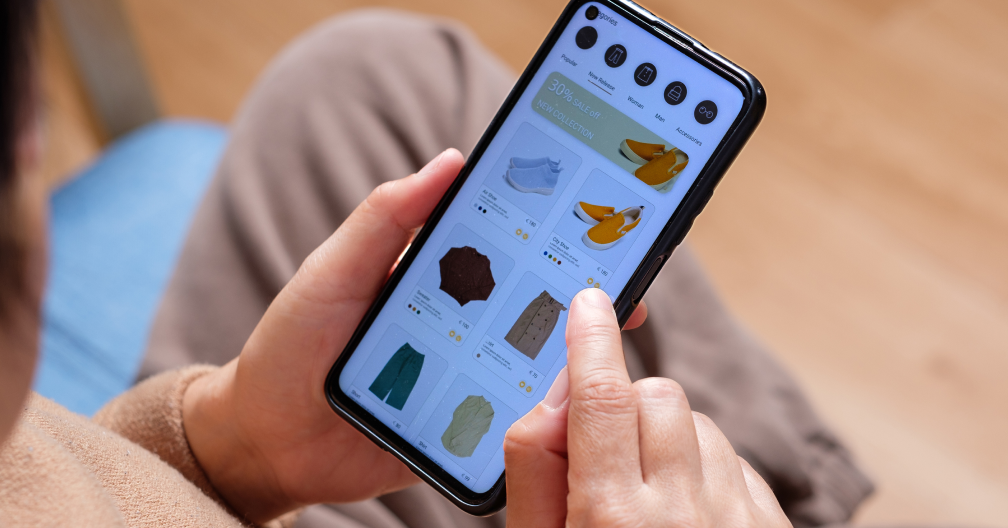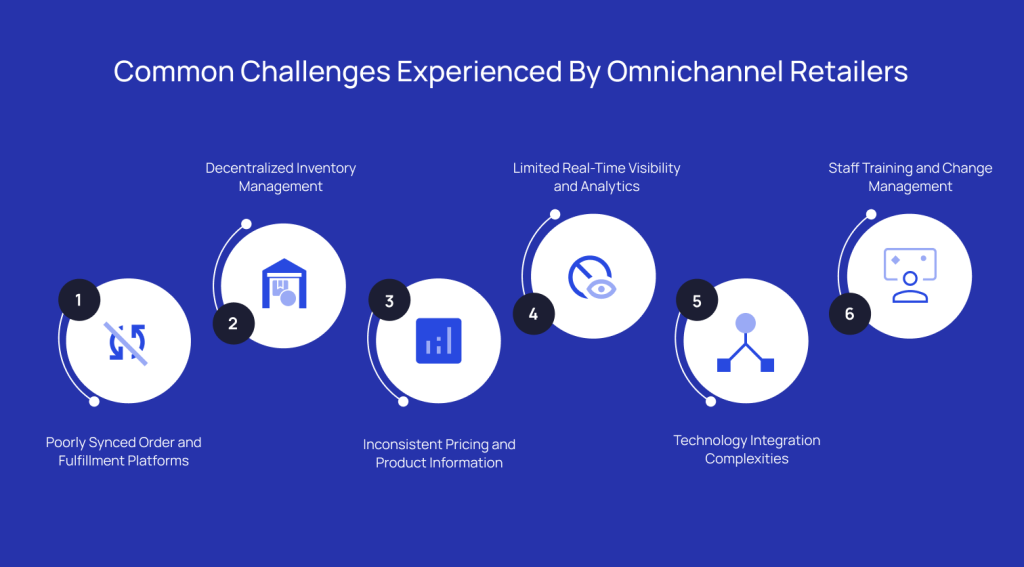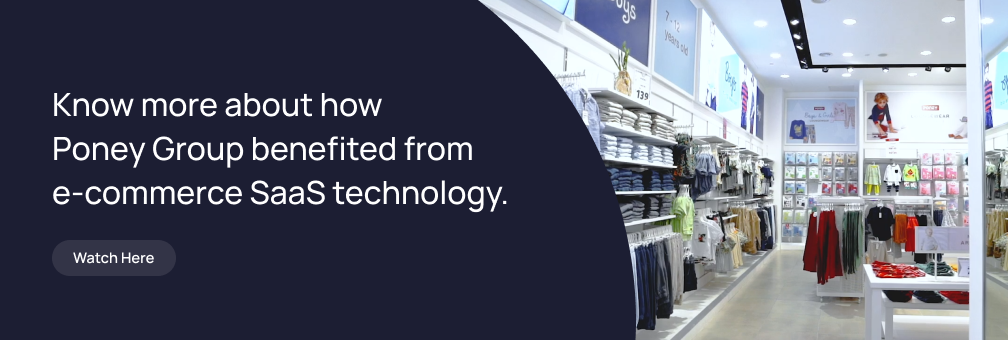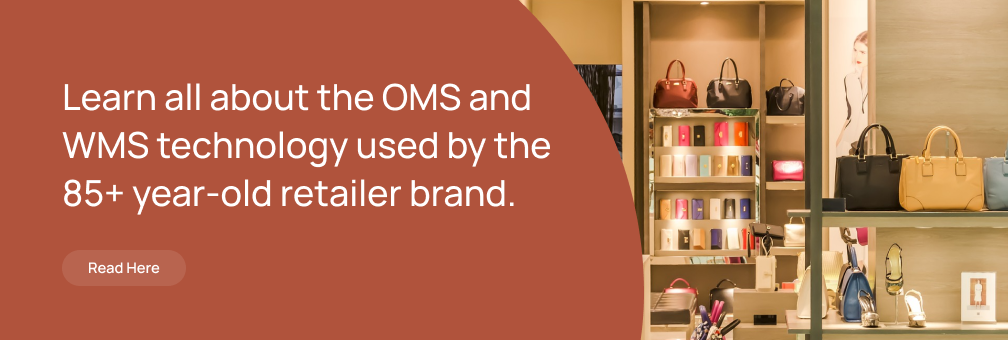Omnichannel Retail Challenges and Solutions: A Complete Guide
Guides
The potential of all retail channels is immense today. Instead of bouncing between online and offline, present-day consumers expect to have a consolidated experience with both retail channels. This shift toward integrated shopping experiences has made omnichannel retail not just a competitive advantage but a necessity for survival in today’s market.
Eric Hazan, the Senior Managing Partner at McKinsey (Paris), captures this transformation perfectly. He says, “We are entering the world of ‘phygital’—physical and digital at the same time, where there is not a physical world or digital world in retail, but rather a completely connected one.” [1]
Consumer data reinforces this trend. For example:
- Shoppers are 19.8% more likely to purchase from stores offering omnichannel pick-up services.
- Omnichannel customer engagement increases sales revenue growth by an average 179% more than companies that do not implement similar strategies.
- Omnichannel shoppers deliver a 30% higher lifetime return on investment than single-channel shoppers. [2]
These statistics represent just a fraction of the value provided by the evolving omnichannel market. As consumer demands grow more sophisticated, so do the complexities of meeting their needs through effective omnichannel strategies.
Vicky Hardiman, Country Head for Indonesia at Anchanto, explains, “Omnichannel retail is increasingly complex as there are many moving parts involved. The execution of omnichannel retail is somewhat different for each industry, and sometimes even in the same industry, various businesses may have unique processes depending on market or customer demand.”
Understanding what omnichannel e-commerce is and mastering omnichannel order management has become critical for retailers who want to stay competitive. However, successful implementation means overcoming certain challenges linked with this business model.
In this guide, we will explore the most pressing omnichannel challenges faced by retailers like you today, examine proven solutions that top omnichannel retailers use to overcome these obstacles, and provide actionable insights for scaling your omnichannel retail system effectively. But first, let’s break down the concept of omnichannel retail.
What is Omnichannel Retail and Why It Matters Today
Omnichannel retail represents a strategic approach that creates seamless, integrated customer experiences across all touchpoints, whether online (websites, apps, social media) or offline (physical stores, pop-ups, events). Unlike multichannel retail, which operates separate sales platforms independently, omnichannel retail ensures these channels work together harmoniously.
Modern consumers expect a unified brand experience regardless of how they interact with your business. This shift has made omnichannel retail adoption essential for businesses seeking to meet evolving customer expectations.
Key benefits of implementing omnichannel retail include:
- Enhanced Customer Experience: Customers can start their journey on one channel and seamlessly continue on another without friction or inconsistency.
- Increased Sales Opportunities: By providing multiple touchpoints, you capture customers at different stages of their buying journey, leading to higher conversion rates.
- Improved Customer Loyalty: Consistent, convenient experiences across all channels build stronger relationships and encourage repeat purchases.
- Better Data Insights: Integrated channels provide a comprehensive view of customer behavior, enabling more personalized marketing and improved decision-making.
- Competitive Advantage: As customer expectations rise, superior omnichannel capabilities will differentiate your business from competitors still operating in silos.
Common Omnichannel Retail Challenges
Implementing effective omnichannel retail isn’t without its obstacles. Even the most successful retailers face significant omnichannel challenges when trying to unify their operations across multiple touchpoints. Understanding these challenges is the first step toward developing solutions that work.

1. Poorly Synced Order and Fulfillment Platforms
Managing online and offline channels separately is challenging enough, but the complexity multiplies when you combine them through services like buy online and pick up offline (BOPIS), try offline and buy online, or curbside pickup.
In these scenarios, orders must be communicated instantly to the store or distribution center closest to the customer. The item must then be processed and packaged quickly for pickup, as customers often expect same-day availability.
Legacy systems or manual processes for communicating omnichannel orders create significant bottlenecks. These outdated approaches require manual intervention, causing delays in order transmission and increasing the risk of miscommunication or lost orders.
This poor synchronization not only delays order completion but also creates disappointing customer experiences. Research indicates that only 1 in 10 consumers [3] believe businesses can deliver truly seamless omnichannel experiences. Poorly synced order and fulfillment channels are a major contributing factor to this perception.
2. Decentralized Inventory Management
Inventory visibility across multiple locations represents one of the most complex omnichannel challenges. When online orders arrive and the nearest fulfillment center has low inventory, you need to quickly identify alternative fulfillment locations to complete orders without delays.
This challenge affects various order types:
- Standard online orders requiring fulfillment
- BOPIS orders needing in-store preparation
- Store-to-online transfers for out-of-stock items
Without real-time inventory visibility across warehouses, stores, and fulfillment centers, you risk delivery delays, missed service level agreements (SLAs), and customer dissatisfaction. Legacy systems often fail to provide real-time inventory updates, meaning you might continue accepting orders for out-of-stock items with no alternative fulfillment options. This creates a backlog of unfulfillable orders until stock replenishment occurs.
As Vicky Hardiman notes, “This is one of the major omnichannel retail challenges. Failing to maintain inventory accuracy across multiple channels can result in overselling and underselling, and could make it difficult to satisfy urgent orders, orders for out-of-stock products, or bulk purchases.”
3. Inconsistent Pricing and Product Information
Product description and pricing disparities across channels create significant friction in the customer journey. Today’s consumers engage in cross-channel shopping behaviors like showrooming and webrooming [4], examining products in physical stores before purchasing online, or researching online before buying in-store.
Consider a customer who researches laptops online to compare specifications and pricing, then visits a physical store to examine the product firsthand before making their final purchase decision. If they discover pricing discrepancies or conflicting product information between channels, it undermines trust and can drive them to competitors.
Recent surveys show that 51% of consumers [6] “click and ship”—making purchases through their phones while inside a retailer’s store. Additionally, 6 out of 10 shoppers make mobile purchases from inside retail stores, though many of these purchases are made through competitors’ websites rather than the store they’re visiting.
These statistics highlight why consistent pricing and product information across all channels is crucial. Discrepancies can make customers feel deceived or cause them to question the authenticity of your products.
4. Limited Real-Time Visibility and Analytics
Selling through multiple online and offline platforms makes it extremely difficult to track sales performance, customer preferences, and inventory levels comprehensively. Without systems capable of collecting data rapidly and generating immediate reports, you lack the real-time visibility necessary for effective decision-making.
This visibility gap affects multiple operational areas:
- Performance assessment and SLA monitoring
- Personalized customer experience delivery
- Inventory forecasting and stock planning
- Promotional effectiveness measurement
- Delivery optimization and fulfillment coordination
Insufficient data visibility also prevents effective order management across different outlets, making it impossible to minimize delivery times or avoid stock shortages proactively. Without knowing which locations will handle specific deliveries, optimizing last-mile delivery becomes nearly impossible.
5. Technology Integration Complexities
Many retailers struggle with integrating different systems that weren’t designed to work together. Point-of-sale systems, e-commerce platforms, inventory management tools, and customer relationship management systems often operate in isolation, creating data silos that prevent true omnichannel functionality.
Additionally, collecting and unifying customer data across multiple touchpoints presents significant challenges. When customer information exists in separate systems for online and offline interactions, creating personalized experiences becomes extremely difficult.
6. Staff Training and Change Management
Implementing omnichannel retail requires significant changes to operational procedures and staff responsibilities. Training employees to work effectively across channels while maintaining service quality standards adds another layer of complexity to omnichannel implementation.
Proven Solutions to Overcome Omnichannel Challenges
Understanding omnichannel challenges is only half the battle. The key to success lies in implementing proven solutions that address these obstacles systematically. With proper technology infrastructure and strategic planning, even the most complex omnichannel challenges become manageable.
Sajal Kohl, Senior Partner at McKinsey Chicago, emphasizes this point in an omnichannel insights report, “A lot of the resource investment—both human capital and capital expenditure in dollars—needs to shift away from opening new brick-and-mortar stores and toward putting it into technology.” [6]
To bridge existing gaps in omnichannel retail and centralize operations effectively, adopting advanced technology solutions, specifically cloud-based Software as a Service (SaaS) platforms, makes a lot of sense. Without proper SaaS systems managing offline and online operations, the silos between sales, warehousing, and fulfillment operations will persist.
Here’s how SaaS solutions power successful omnichannel:

1. Centralized Selling Across Sales Channels
Effective omnichannel retail requires managing sales appropriately while ensuring inventory visibility across all channels for both replenishment and order fulfillment. This can be achieved through the strategic combination of an Order Management System (OMS) and Warehouse Management System (WMS).
| System | Key Benefit |
| Order Management System | – Centralizes orders from all online sales channels for comprehensive monitoring |
| – Ensures pending orders receive immediate attention | |
| – Tracks offline sales through POS integrations for complete visibility | |
| – Provides seamless integration with third-party logistics providers (3PLs) | |
| Enables faster order processing across all channels | |
| Warehouse Management System | – Consolidates inventory management across stores and warehouses for better control |
| – Automates major order fulfillment processes | |
| – Synchronizes inventory management with order processing | |
| – Accelerates online order fulfillment | |
| – Enables efficient stock replenishment across locations |
Cloud-based OMS and WMS solutions also enable sophisticated inventory segregation, allowing businesses to designate specific products for online-only or offline-only sales. This capability is particularly valuable for promotional strategies targeting specific channels.
2. Synchronized Order and Fulfillment Channels
Beyond basic online and offline retail operations, top omnichannel retailers combine channel features to offer convenient, personalized services like BOPIS, “try offline buy online,” and “buy online return offline options.”
A powerful OMS makes these complex fulfillment scenarios manageable by automatically alerting the appropriate store or fulfillment center for each order type. For example, when a customer places an online order for shoes with store pickup, the OMS immediately notifies the store location closest to the customer and initiates preparation for pickup. This automation eliminates manual communication gaps while ensuring customers receive timely notifications about order status and pickup availability.
3. Centralized Inventory Across Warehouses and Stores
Cloud-based WMS solutions centralize stock visibility across private warehouses and retail stores through a single, unified platform.
Vicky Hardiman explains, “A transparent and real-time warehouse management system is mandatory to have visibility for different stock movements.”
Key capabilities of these WMS systems include:
- Real-time stock level monitoring across all locations
- Automatic inventory deductions when items are picked and processed
- Immediate inventory updates when new stock arrives
- Returned product tracking and processing
- Monitoring of damaged goods, reserved stock, and promotional items
Complete inventory visibility enables seamless coordination of online order deliveries and pickups. When one store experiences high demand and depleting stock, you can easily transfer orders to nearby locations or offer customers alternative fulfillment options like online ordering with later delivery.
4. Product Information Management Solutions
Maintaining uniform product and pricing information across all retail channels requires a centralized source of product data. Product Information Management (PIM) systems provide this centralization, ensuring all channels display consistent, accurate information.
PIM system benefits include:
- Universal product details and pricing maintenance
- Automated updates across multiple channels simultaneously
- Controlled access for authorized personnel only
- Instant implementation of pricing and product changes
Product information uniformity builds customer confidence in your brand while encouraging the use of omnichannel features like BOPIS. Additionally, PIM systems enable sophisticated promotional management, including customized offers, discounts, pre-booking options, and omnichannel flash sales.
Competitive intelligence systems like Digital Shelf Analytics technology complement PIM systems by providing competitor insights, including product details, reviews, and pricing information for strategic comparison and performance monitoring.
5. Advanced Integration Capabilities
Modern OMS and WMS systems offer extensive integration capabilities that consolidate real-time data from multiple channels and interconnected ecosystems. These integrations enable complete visibility of sales performance, inventory levels, and operational efficiency.
System, partner, and channel integration capabilities include:
- Multiple marketplace and online store connections
- Brick-and-mortar outlet synchronization
- Carrier and fulfillment partner communication
- Delivery tracking and delay prediction
- Customer and pickup point notifications
The powerful API integration technology in today’s OMS and WMS platforms can also synchronize with existing business systems like SAP, QuickBooks, POS systems, and ERPs. This compatibility ensures you don’t need to abandon systems your team already uses effectively.
These comprehensive integrations enable sophisticated reporting and forecasting capabilities, supporting sales and inventory planning, customer experience customization, strategy refinement, and critical business decision-making.
Key Considerations Before Scaling Omnichannel Retail
Successfully scaling omnichannel retail requires careful planning and consideration of multiple factors that can impact implementation success. Before expanding your omnichannel capabilities, evaluate these critical areas to ensure sustainable growth and optimal customer experiences.
1. Technology Infrastructure Assessment
Evaluate your current technology stack’s ability to handle increased complexity and volume. Legacy systems that struggle with basic omnichannel functions will become even more problematic at scale. Consider whether your existing infrastructure can support:
- Increased transaction volumes across multiple channels
- Real-time data synchronization between systems
- Advanced analytics and reporting requirements
- Integration with new platforms and services
- Scalable cloud-based architecture needs
- Financial Investment and ROI Planning
Omnichannel scaling requires significant investment in technology, training, and operational changes. Technology platform costs and implementation expenses typically represent the largest portion of your budget, but don’t overlook staff training and change management resources. Operational procedure modifications often require extensive testing phases, while performance monitoring and optimization tools provide ongoing value. Develop realistic ROI timelines that account for the gradual nature of omnichannel benefits realization.
2. Customer Experience Consistency
As you scale across more channels and touchpoints, maintaining consistent customer experiences becomes increasingly challenging. Brand message consistency across all channels forms the foundation of customer trust, while service level maintenance during expansion periods requires careful resource allocation. Quality control procedures for new touchpoints must be established early, supported by robust customer feedback collection and response systems that enable continuous experience improvement.
3. Organizational Change Management
Scaling omnichannel retail often requires significant organizational changes that affect multiple departments simultaneously. Staff training on new systems and procedures must be comprehensive and ongoing, as role redefinition and responsibility clarification can create temporary confusion without proper communication. Clear communication protocols between departments become essential when operations span multiple channels, requiring performance measurement and incentive alignment that supports collaborative rather than siloed thinking.
4. Data Security and Compliance
With increased data flow across multiple channels comes greater responsibility for security and compliance across all customer touchpoints. Regulatory compliance requirements such as GDPR [7] and CCPA [8] become more complex when customer data moves between online and offline systems. Payment security standards and certifications must be maintained across all channels, supported by comprehensive data backup and disaster recovery procedures. Privacy policy updates and customer communication should reflect the expanded data collection and usage across your omnichannel operations.
5. Performance Measurement Framework
Establishing comprehensive metrics and KPIs before scaling enables effective tracking of success while identifying areas for improvement. Customer satisfaction scores across all channels provide the ultimate measure of omnichannel success, while order fulfillment accuracy and speed metrics reveal operational effectiveness. Monitor inventory turnover and availability rates to ensure optimal stock management, alongside channel-specific conversion and retention rates that highlight the most valuable touchpoints. Operational efficiency and cost-effectiveness measures help justify continued investment in omnichannel capabilities.
Examples of Omnichannel Retail Using OMS and WMS Technology
Real-world implementation examples demonstrate how OMS and WMS technology combinations create successful omnichannel retail operations. These systems work together to track orders and inventory while sharing accurate information across retail networks, enabling automated operations that handle large order volumes and complex requests efficiently.
1. Poney Group: Managing High-Volume Operations
Poney Group, a leading children’s wear brand in Malaysia with over 40 domestic retail locations and presence in 9 countries, exemplifies successful omnichannel scaling. The brand operates e-commerce platforms, international business divisions, and physical retail stores across multiple markets.
Despite their substantial market presence, Poney Group struggled with efficient order management and fulfillment at scale.
Rudy Dong Chao, Head of E-commerce and International Business Union at Poney Group, explains: “When our orders shot up in 2020, we were unable to keep up through manual processes. That’s when we realized we needed a solution to fulfill orders within limited operation time and fixed manpower.”
After implementing Anchanto’s SaaS technology, Poney Group achieved:
- Comprehensive inventory management across all locations
- Centralized sales channel control and monitoring
- Significantly reduced error rates and operational costs
- Enhanced flexibility for meeting customer requirements
- Expanded product exposure across different markets
N. Gopala Krishnan, Warehouse and Distribution Manager at Poney Group, sais, “Before Anchanto, there were a lot of error orders and picking errors adding to costs. Finding the exact products ordered across 1000 locations was a big challenge every day, which again led to delays, cancellation and return expenses.”

2. Luxasia: Premium Beauty Retail Excellence
Luxasia operates as an omnichannel beauty retailer across the APAC region with over 2,000 retail stores spanning 11 countries. The retailer represents prestigious beauty brands including Guerlain, Hermès, Loewe, Paco Rabanne, and Calvin Klein, requiring exceptional operational standards to match their luxury brand positioning.
Managing an omnichannel network across 11 countries while serving both online and offline customers created significant challenges:
- Limited performance control and operational visibility
- Operational errors due to misaligned sales channels
- Restricted growth from limited e-commerce ecosystem experience
- Inability to replace established SAP systems
After implementing Anchanto Order Management software, Luxasia achieved remarkable results within just one year:
- 7X business growth across all channels
- Successful expansion across e-commerce marketplaces
- Operational transformation using existing assets
- Complete control and visibility across all regions
- Error-free e-commerce management implementation

3. Valiram: Luxury Goods Omnichannel Integration
Valiram, a luxury goods and retail specialist with an extensive portfolio of more than 200 international brands, chose Anchanto’s OMS and WMS technology to enable their comprehensive e-commerce vision and strategy.
Mukesh Valiram, Executive Director of Valiram, emphasized, “To expose our portfolio of brands to a wider audience, and offer them a unified experience across online and offline sales channels, we need a strong technology infrastructure.”
Their mission focused on building scalable backend operations while maintaining the quality standards expected by global brands such as Michael Kors, Tumi, Tory Burch, Victoria’s Secret, Bath & Body Works, and Giuseppe Zanotti.
With Anchanto’s SaaS technology implementation, Valiram plans to achieve:
- Significant increases in operational efficiency and quality
- Consolidated and standardized digital processes
- Scalable growth across various sales channels
- Enhanced brand exposure and customer reach

These case studies demonstrate that successful omnichannel retail implementation requires robust technology infrastructure combined with strategic planning and execution. The right OMS and WMS solutions enable businesses to overcome complex operational challenges while scaling effectively across multiple channels and markets.
Conclusion
Omnichannel retail continues evolving to enhance consumer shopping experiences while helping businesses reduce delivery and return costs through strategic channel integration. The challenges we’ve explored, from inventory synchronization to order management complexities, are substantial but not unconquerable. As demonstrated by successful retailers like Poney Group, Luxasia, and Valiram, the right technology infrastructure can transform these obstacles into competitive advantages.
Success in omnichannel retail depends heavily on implementing supportive technology stacks like OMS and WMS systems that seamlessly integrate online and offline operations. Advanced SaaS systems provide complete business control, comprehensive insights, and clear visibility across sales, operations, and inventory management. The future of retail lies in creating seamless, integrated experiences that serve customers however they prefer to shop, and businesses that invest in robust omnichannel capabilities today will be better positioned to thrive as consumer expectations continue evolving.
Ready to transform your retail operations and overcome omnichannel challenges? Discover how Anchanto’s proven technology solutions can help you achieve seamless omnichannel success.
FAQs
1. What does omnichannel mean in retail?
Omnichannel retail is a strategy that provides a seamless and consistent customer experience across all touchpoints, whether online (websites, apps, and social media) or offline (physical stores).
2. What is an example of an omnichannel retail strategy?
An example of an omnichannel retail strategy would be a customer researching a new pair of shoes online, browsing the selection on the company’s website, checking for in-store availability at their nearest location, and then heading in-store for pickup. Upon arriving at the store, they try on the shoes and, satisfied with the fit, complete the purchase.
3. What are the three elements of omnichannel retailing?
The connected experience of omnichannel retailing, where online and offline channels work hand-in-hand, highlights the following core elements:
- Integrated Channels: A seamless flow of information and centralized customer data across all touchpoints
- Consistent Brand Experience: Maintaining a unified brand identity and customer experience regardless of the channel
- Customer-Centric Approach: Prioritizing customer convenience, needs, and preferences throughout the entire shopping journey
4. What are the biggest omnichannel challenges retailers face?
The most significant omnichannel challenges include poorly synced order and fulfillment platforms, decentralized inventory management, inconsistent pricing and product information across channels, and limited real-time visibility into operations and customer data.
5. How can retailers overcome omnichannel inventory management challenges?
Retailers can address inventory challenges by implementing cloud-based Warehouse Management Systems (WMS) that provide real-time visibility across all locations, automate inventory updates, and enable centralized stock management across warehouses and retail stores.
6. What technology is essential for successful omnichannel retail?
Essential technologies include Order Management Systems (OMS) for centralized order processing, Warehouse Management Systems (WMS) for inventory control, Product Information Management (PIM) systems for consistent product data, and integration platforms that connect all channels seamlessly.
References –
[1] – Mckinsey.com – Omnichannel Shopping on 2030
[2] – Capitaloneshopping.com – Omnichannel Statistics
[3] – Cbinsights.com – The Technology Driving The Omnichannel Retail Revolution
[4] – Criteo.com – BOPIS, Showrooming, and the Hybrid-Channel Future of Shopping
[5] – Cbinsights.com – The Technology Driving The Omnichannel Retail Revolution
[6] – Mckinsey.com – Omnichannel Shopping on 2030
[7] – Gdpr-info.eu – GDPR Definitions
[8] – Oag.ca.gov – CCPA Regulations
